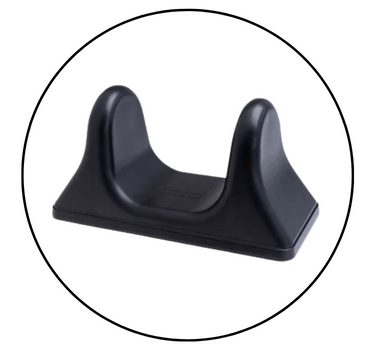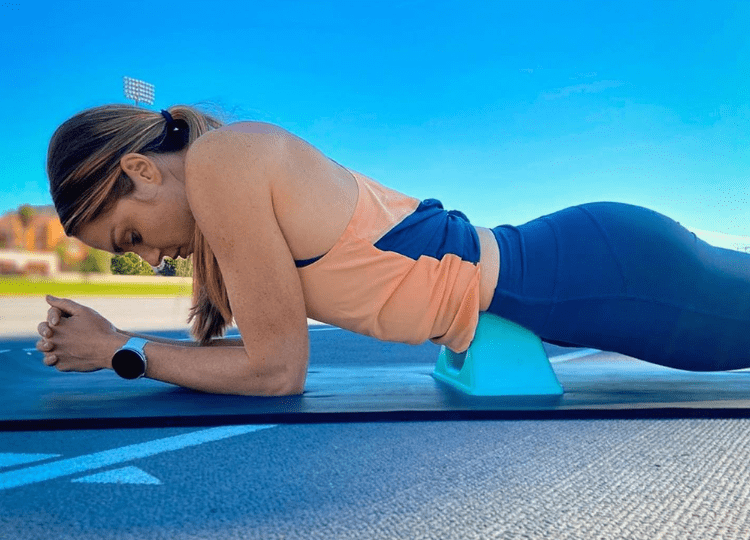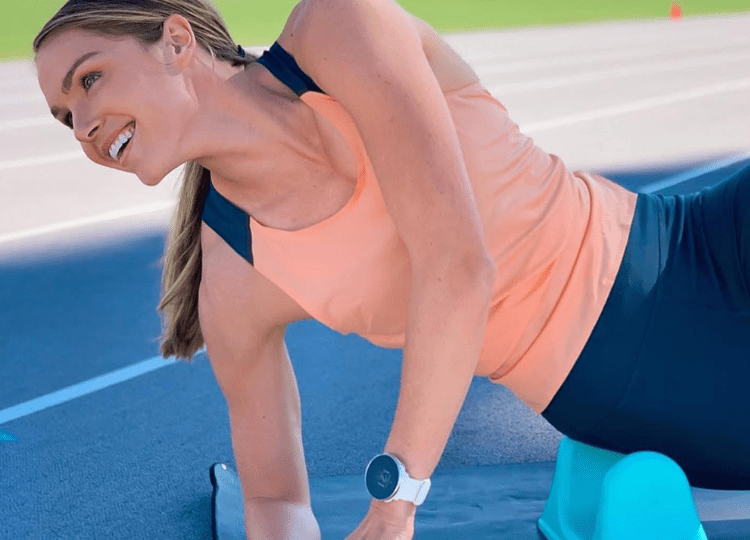We may earn a small commission on some links at no extra cost to you. Learn more.
The psoas muscles (part of the hip flexors) are often overlooked when it comes to strength training and stretching… but these muscles play an integral role in supporting the spine, hips, breathing and basic movements like walking.
They have a unique role in connecting the upper and lower body together.
Ultimately, this means tight, weak or strained psoas muscles are going to seriously limit your overall movement.
One product that promises to enhance your efforts of releasing tightness in this muscle group is the PSO-RITE. With a large social media following and endorsements from professional athletes, we wanted to take a lot at this popular product to see if it lived up to the hype (and the price tag).
In this PSO-RITE review, we outline everything you need to know about the self massage tool, including what we like, don’t like and ultimately if it’s right for you.

PSO-RITE Psoas Muscle Release and Deep Tissue Massage Tool

PSO-RITE Scorecard – Updated 2023
- Build Quality and Safety – 4.5/5
- Workout Diversity – 3.5/5
- Muscle Engagement – 4.5/5
- Shipping, Customer Support & Warranties – 4/5
- Price – 4/5
- Overall Rating – 4.3/5
Learn more about our review scorecards as part of our editorial review guidelines.
What is PSO-RITE?
The PSO-RITE is a self massage tool, designed specifically to release tightness in the psoas muscles. It is made from durable plastic and has a unique shape that tries to replicate the elbow of a Physical Therapist during a deep tissue massage.
The PSO-RITE has become a popular tool for all sorts of athletes, as well as those who just want to move better.
The product can also be used to massage other parts of the body, such as the glutes and back.

What We Like About PSO-RITE
Effective Tool for Combatting Tight Psoas Muscles
Ultimately, the overarching benefit of using the PSO-RITE massage tool is the ability to combat a tight psoas.
Tightness in these muscles can cause all sorts of musculoskeletal problems, such as hip pain, back ache, compromised hip flexion, poor posture and limited overall mobility.
It doesn’t matter if you’re just looking to stay fit and active, or compete at an elite level of sports, the psoas muscles need to be strong and supple to support healthy movement.
Although stretching and mobility exercises can help in loosening up the psoas muscle group, due to the deep location of these muscles in the body, it is undoubtedly more challenging compared to other muscle groups… which is why a deep tissue massage (whether from a tool like the PSO-RITE, or a massage therapist), is often useful too.
We found the PSO-RITE was definitely useful and effective for combatting a tight psoas muscle… more so than other products we’ve tried.
The simplicity, yet effectiveness, of the tool reminded us of when we tried the pelvic clock… another product that is seemingly just a “piece of plastic”, yet has the power to create transformative results.
Sturdy
The PSO-RITE is made from thick, durable plastic. It’s very solid and there’s no give whatsoever.
This sturdy design is ideal to really push through deep into the muscle tissue.
In fact, it’s designed to be as hard as a Physical Therapist’s elbow… to replicate the force they would use to when performing a deep tissue massage.
Compared to DIY options or lying on a massage/tennis ball, you’ll find that these sorts of things lose their shape or don’t reach deep enough and consequently don’t provide the muscle release that PSO-RITE does. This means you struggle to really massage deep into the tissue.
This does, however, mean it can be more painful than you’re expecting, especially compared to other massage tools you may have used. For anyone who’s had a sports massage will tell you, this isn’t necessarily a relaxing activity and massaging deep tissue can be an uncomfortable experience.

Massages Deep in Muscle Tissue
The unusual shape means you can also roll and adjust your positioning to better find the tender spots and massage your psoas effectively.
You can also change how much of your bodyweight you are supporting… for example, you could use your arms to limit the pressure to begin with, allowing you to customize the massage to better suit your requirements.
In comparison to a foam roller, for example, this is a significant upgrade, as a foam roller only really allows you to massage muscles on the surface.
The caveat to this is, however, that your positioning is more important than other tools, so it might take some time to get used to it and eventually find what works.
Relatively Versatile
PSO-RITE can also be used to massage other parts of the body, including the glutes, too.
We don’t find this as much of a lure as the ability to massage the psoas simply because stretching and a basic foam roller will likely be enough to really address tightness in the glutes and other muscle groups.
But, once you’ve got yourself a PSO-RITE, then you can leverage the tool for other parts of the body, which is definitely a bonus.
(The company also suggests the tool can be used to massage the chest/back, but we didn’t find it that practical for those muscle groups).
Overall Value
The PSO-RITE comes in at around $80, which let’s face it, is quite expensive for a self massage tool made of plastic… but, compared to the price of Physical Therapist sessions, this is undoubtedly the more affordable option.
A tight or strained psoas will eventually catch up with you and the PSO-RITE can definitely save you money if you have issues with this part of your body.
Being in pain is not only limiting… but also expensive, so any product that helps to reduce pain is worth the investment.

Things to Consider
Exercise Instructions
The exercise instruction manual isn’t great for learning how to do all the different exercises on your PSO-RITE.
However, PSO-RITE have put most of these exercises on their YouTube and social media channels, so we’d definitely recommended watching those to understand how to do the exercises properly.
This is important, as you’re simply not going to get any of the benefits if you’re lying on the tool incorrectly. This is why we think the images just aren’t worth using in comparison to the video demonstrations.
Understanding Pain
The difficulty in writing this PSO-RITE review is that the tool largely requires each user to understand their body and understand when to pursue tender spots/pain in the psoas and when to stop.
This ability to understand pain is a huge factor in how successful you’ll be with the product.
Similarly, a lack of understanding could actually cause more damage.
So, if you have any doubts, we’d recommend speaking to a Physical Therapist and perhaps working with them to help you massage your psoas with the tool to begin with, until you are confident in using it by yourself.
Psoas Exercises and Stretches
We would recommend including psoas strengthening exercises and stretches into your fitness routine, regardless of whether you want to pursue deep tissue massage.
Massage with only get you so far, you need to be strengthening and stretching the muscles too.
The Samson stretch, reverse squats, and psoas marches are movements that can help address weakness and tightness in the psoas muscles… and could complement any efforts on your PSO-RITE.

PSO-RITE Psoas Muscle Release and Deep Tissue Massage Tool
Alternatives
Hip Hook
The Hip Hook, from Aletha Health, is probably the main competitor and alternative to PSO-RITE.
The Hip Hook looks more like a modern sculpture than a mobility tool, but the reviews speak for themselves, and most customers give it 5-stars.
It is more expensive than the PSO-RITE (by quite some margin), but the “hook” design does offer a more precise way to target deep in the psoas and iliacus muscles.
We also really like the ability to push on the hook to adjust the pressure. This, to us, feels most similar to what a massage therapist does with their hands.
Mobility Ball
A standard mobility ball (or lacrosse ball) is another potential alternative to the PSO-RITE self massage tool.
Mobility balls vary in quality from brand to brand, but we tend to prefer a dense ball that can withstand your bodyweight so you can really push down on it.
Mobility balls are very versatile, and a great thing to have around the house in general.
Like most mobility and stretching tools, the effectiveness largely depends on how you use the product. We’d recommend watching video demonstrations on using a mobility ball to massage the psoas muscles so you can do it effectively.
Due to the shape, however, the PSO-RITE and Hip Hook are better designed to reach the psoas and iliacus muscles.
Mobility balls will be cheaper and perhaps a better option for those just wanting a single tool for the whole body that is affordable. If you’re really looking to focus on your psoas, the PSO-RITE is probably the better choice.
Why Trusted Us? Review Process Explained
We believe in editorial integrity and only writing reviews that will genuinely help our readers. Before writing this product review, we tested and tried all kinds of other massage tools too, including many of PSO-RITE’s main competitors, giving us a clear and unique view of the overall value you can expect to gain from the product compared to similar options.
Bottom Line
Having strong and supple psoas muscles is going to make a significant improvement in your overall movement so any efforts or products that help achieve this are certainly worth considering.
Although the $80 price tag seems high for a relatively simple product, it is still the cheaper option compared to regular Physical Therapist appointments. Similarly, the impact can be monumental for an athlete.
Consequently, we think the PSO-RITE is a worthy self massage tool and if you have problems with your psoas muscles, it’s a product worth considering.
You can check the latest best price by clicking below.

PSO-RITE Psoas Muscle Release and Deep Tissue Massage Tool
Related Articles
Tib Bar Review – Is It Worth It?
Best Glute Equipment for Home Use
This website, fitnessdrum.com, is a participant in the Amazon Services LLC Associates Program, an affiliate advertising program designed to provide a means for sites to earn advertising fees by advertising and linking to Amazon.com.
